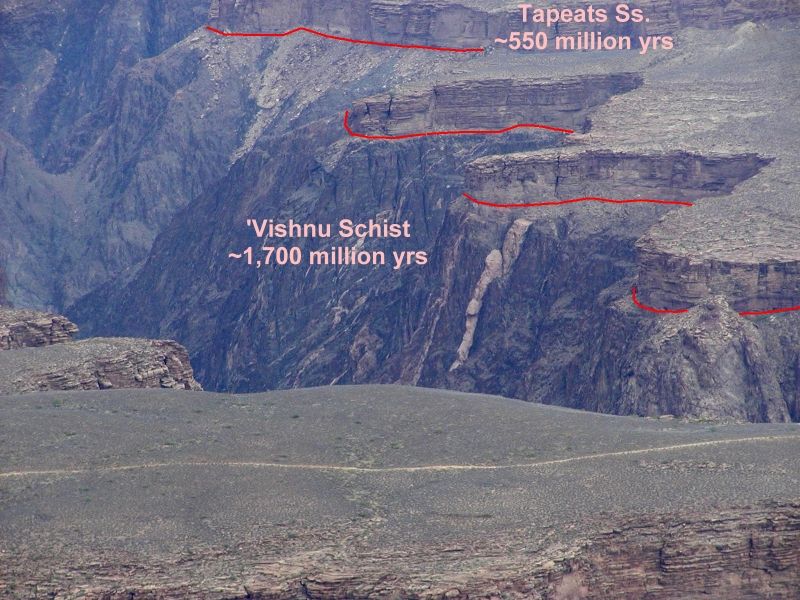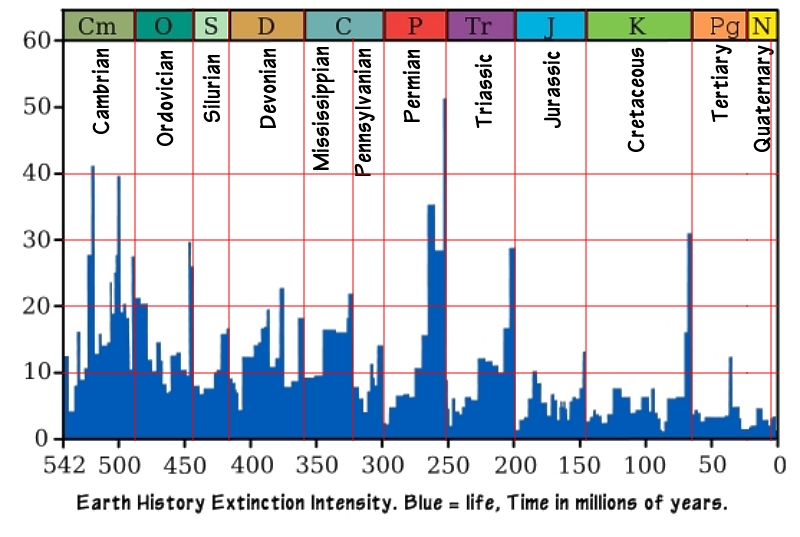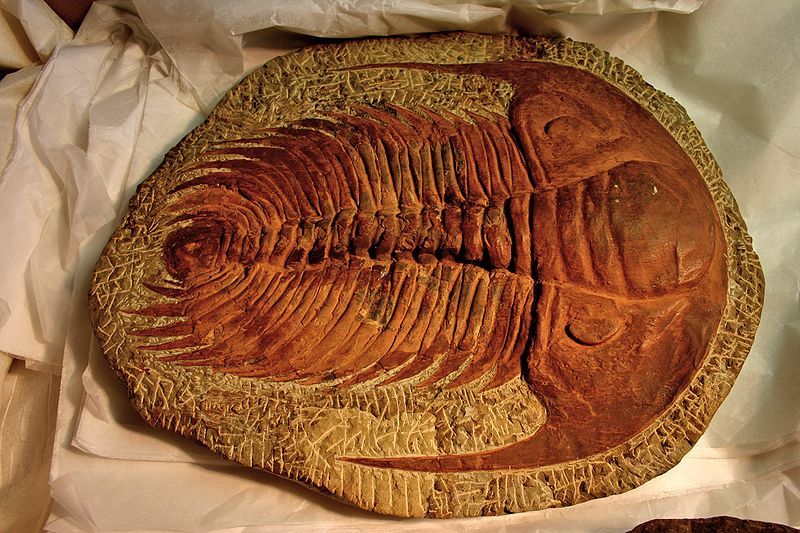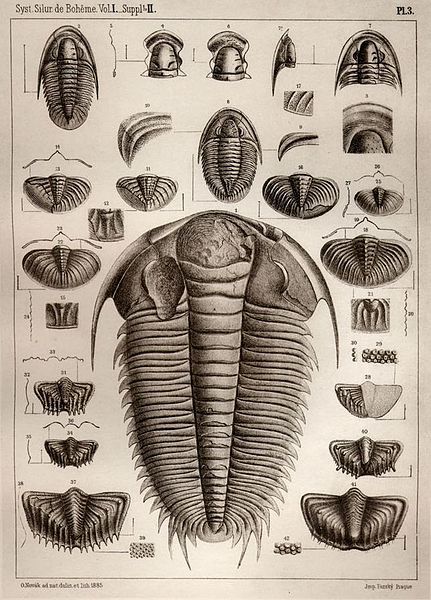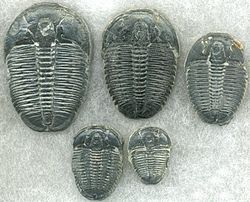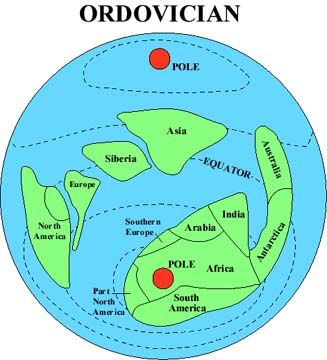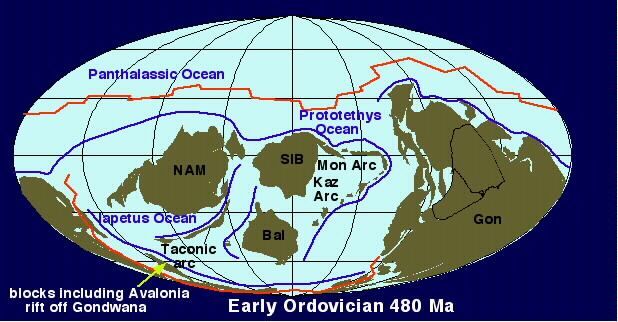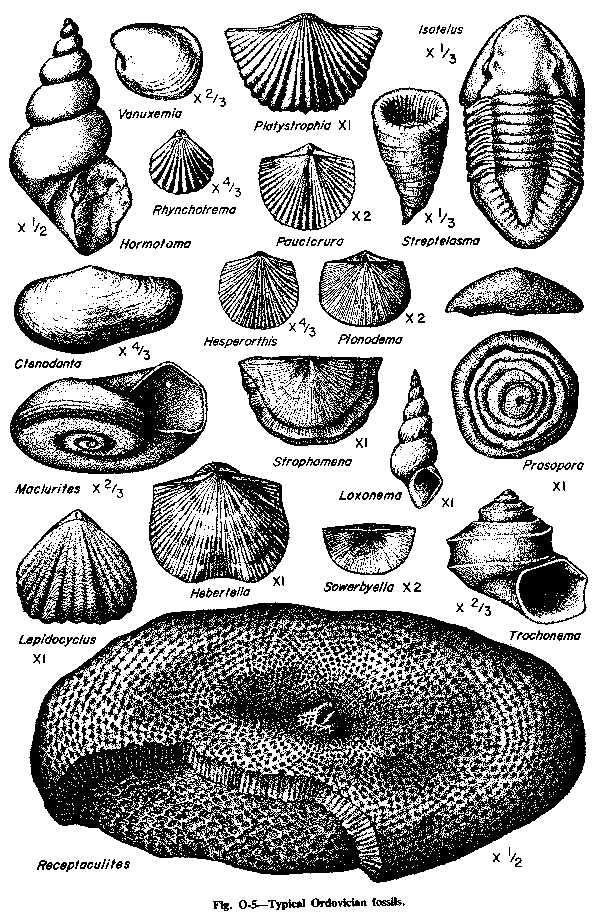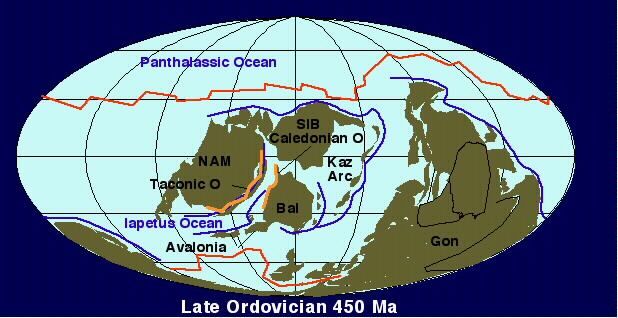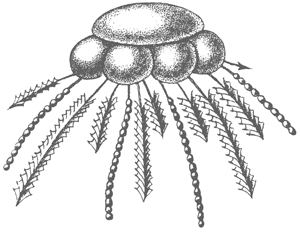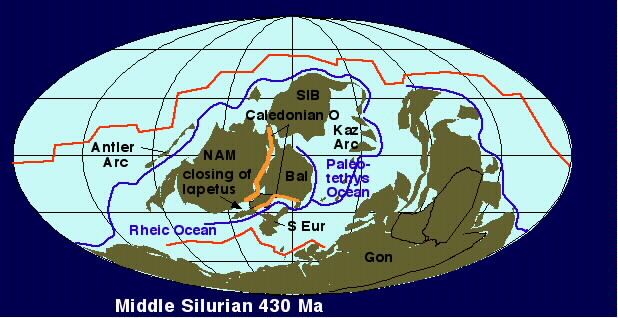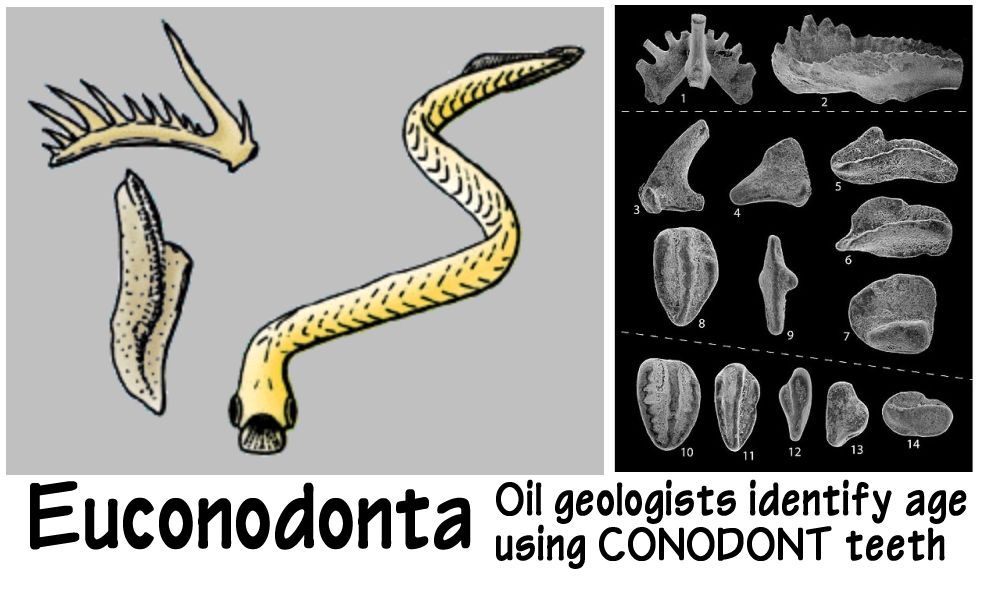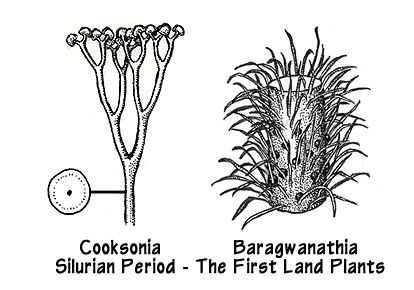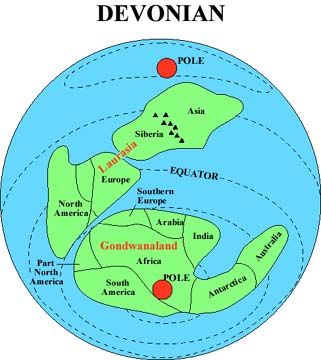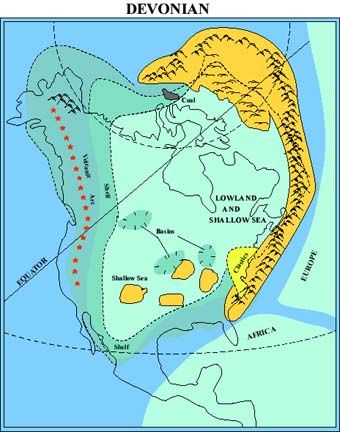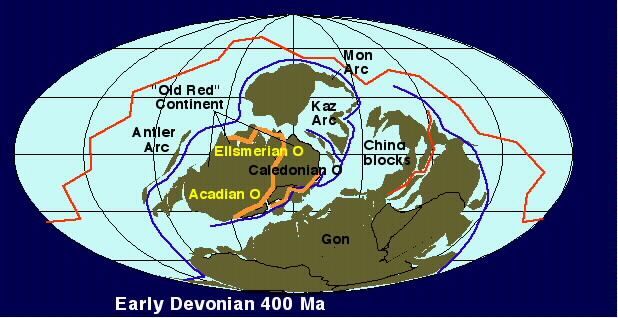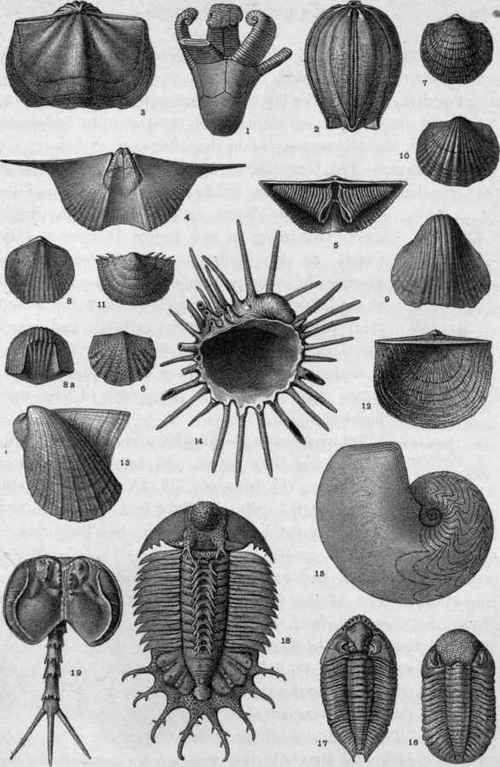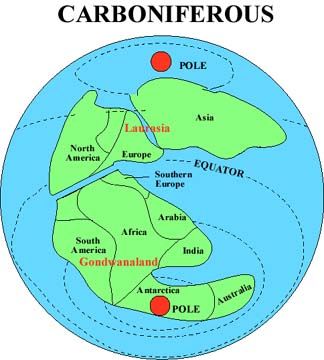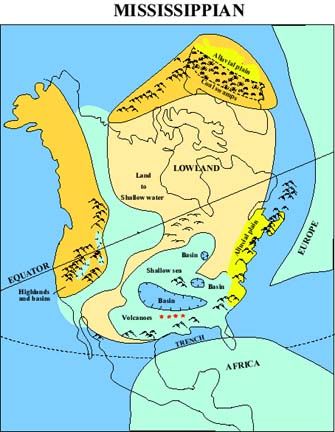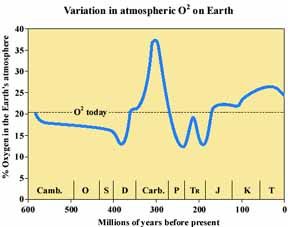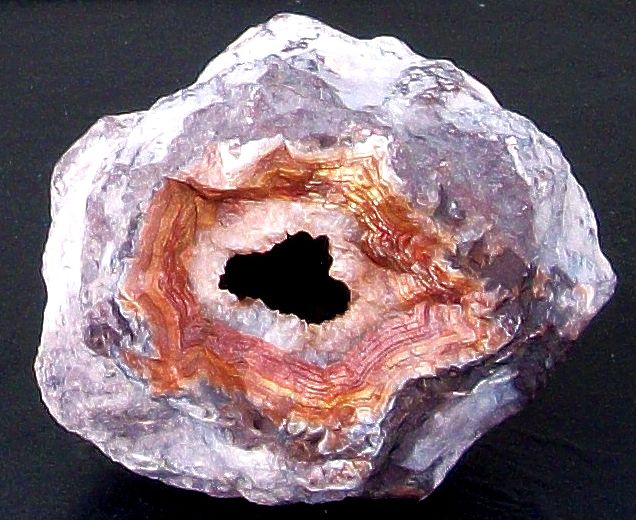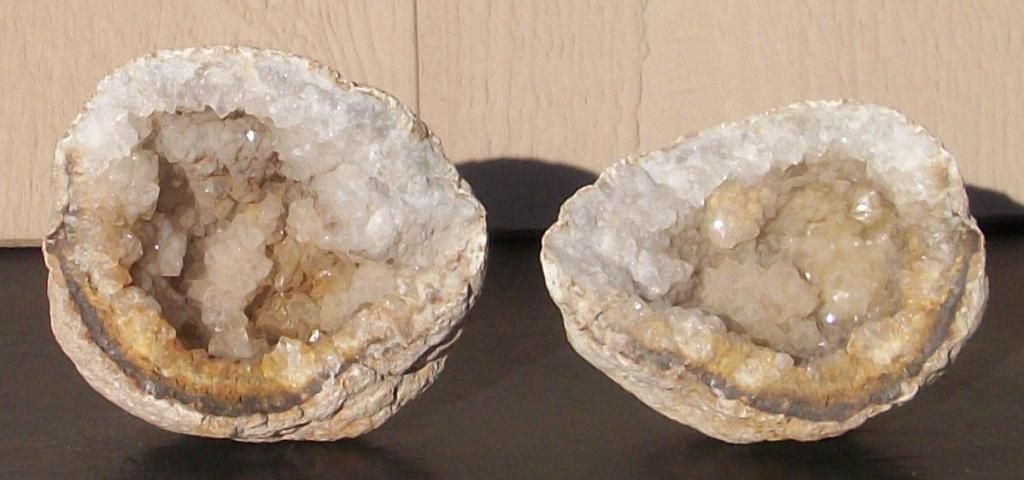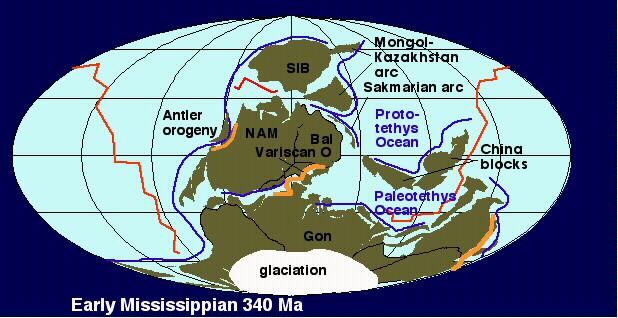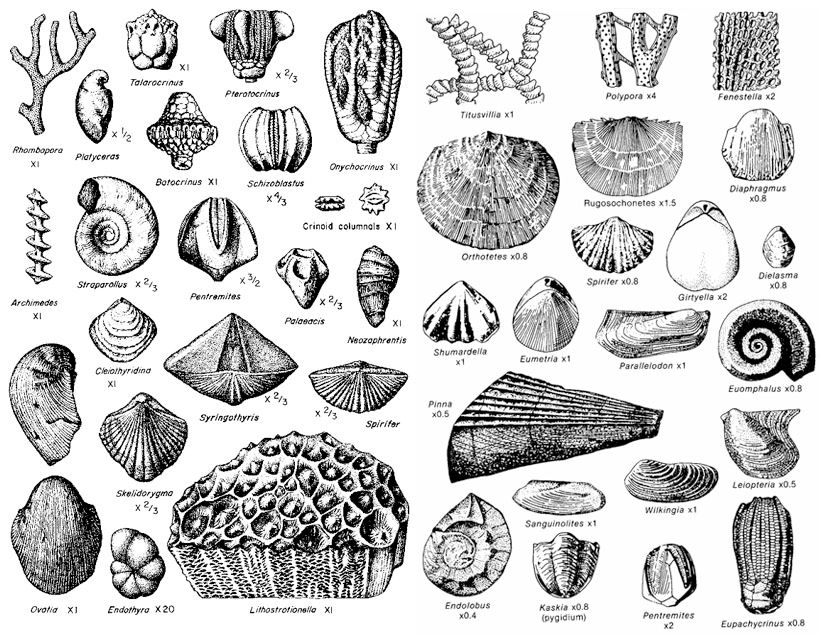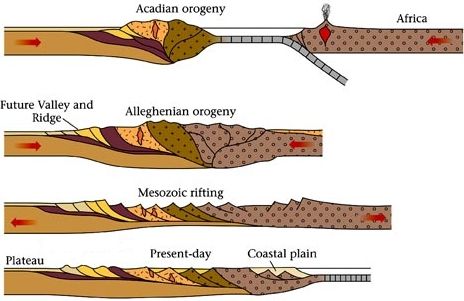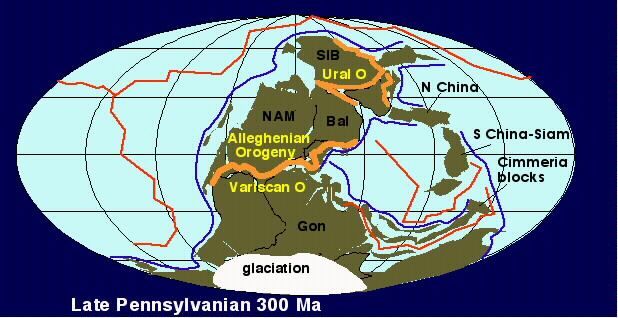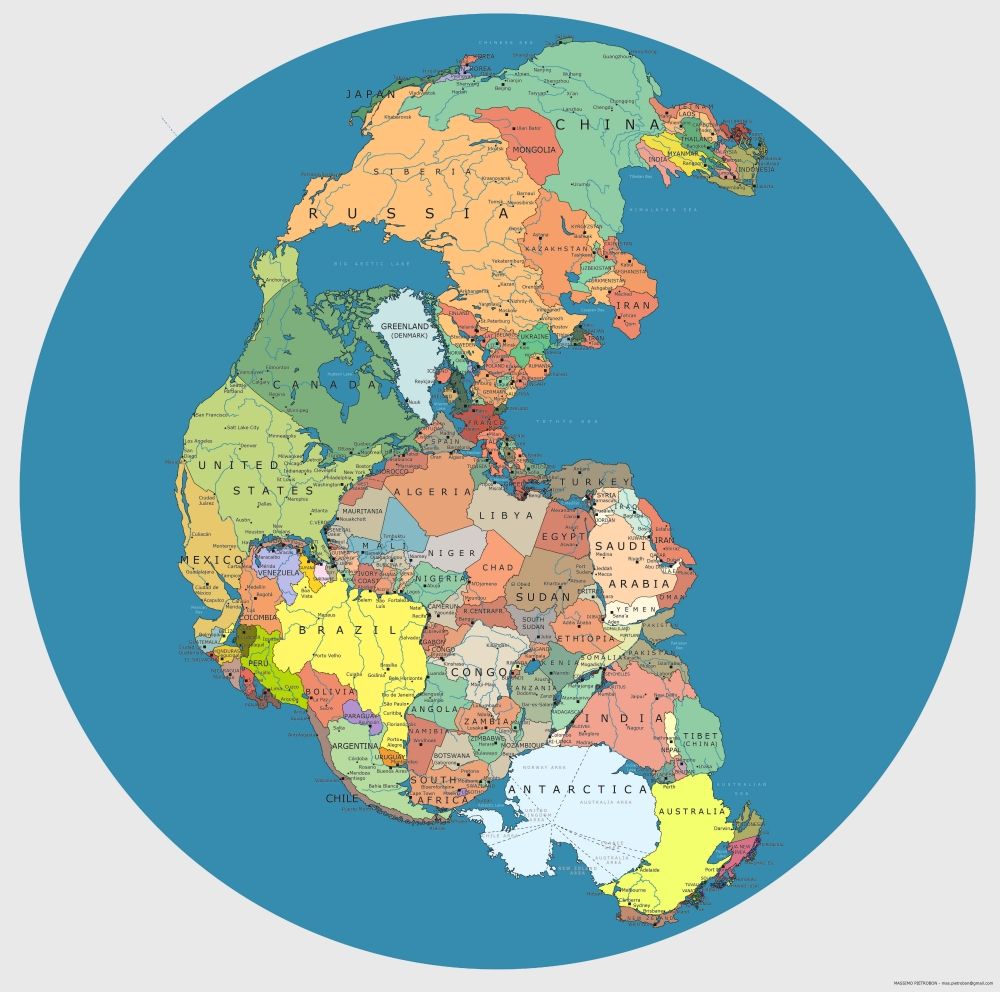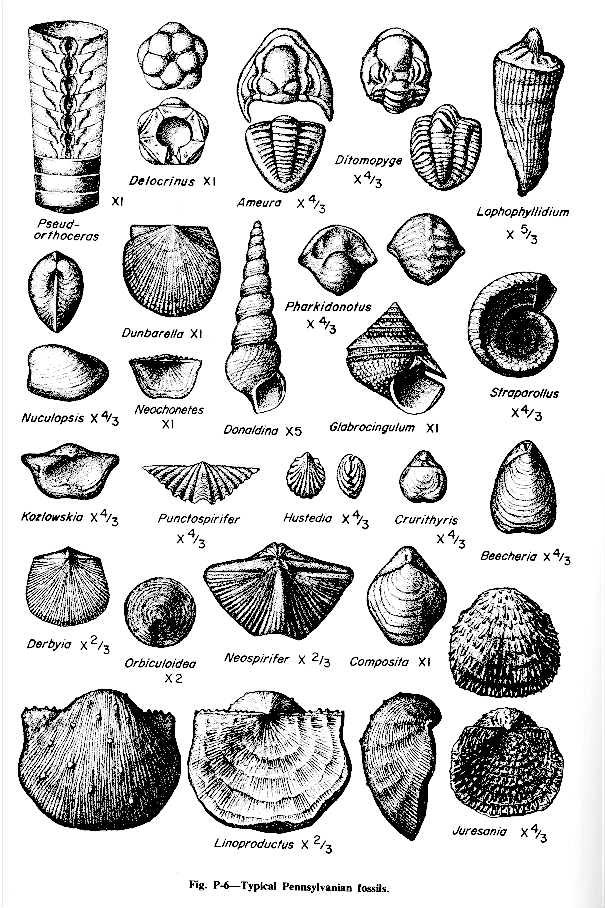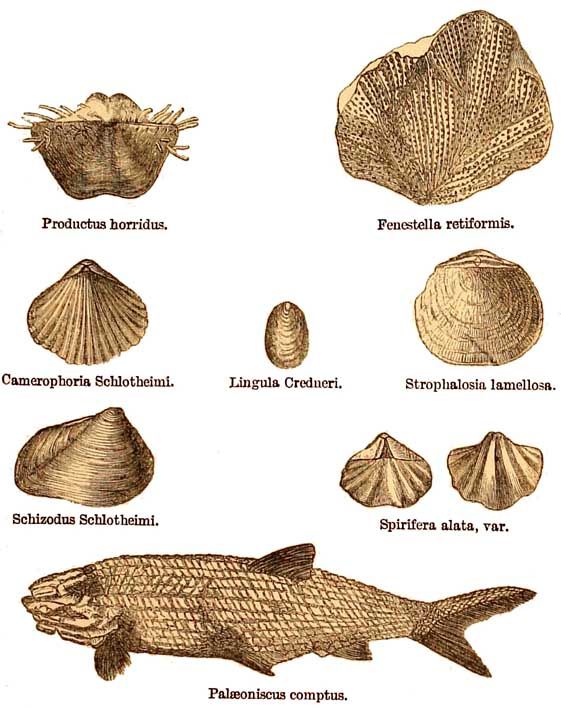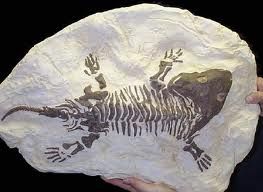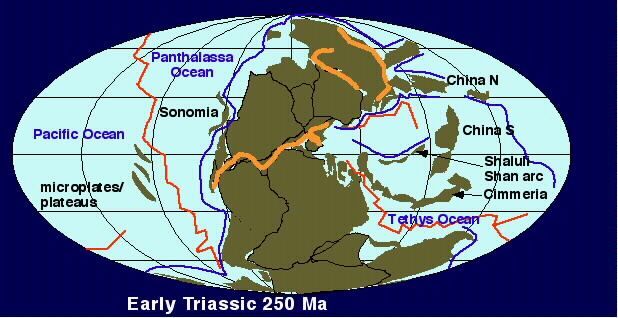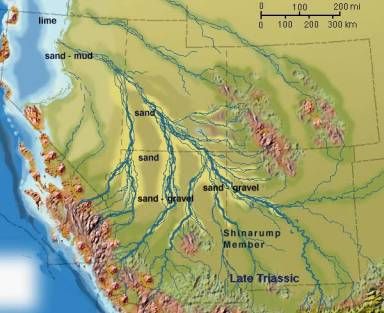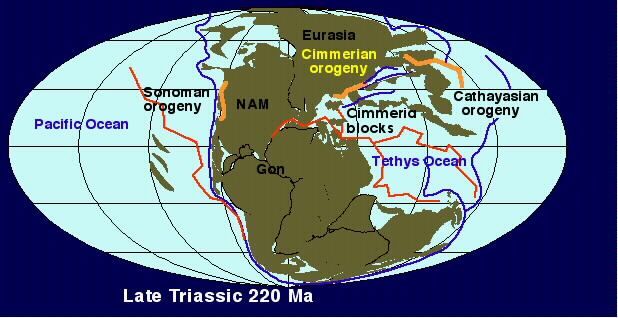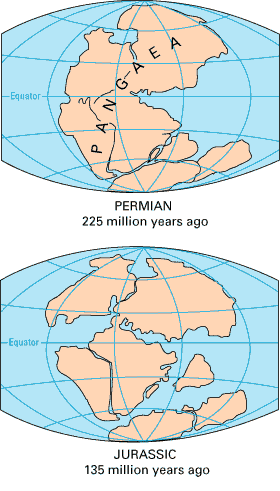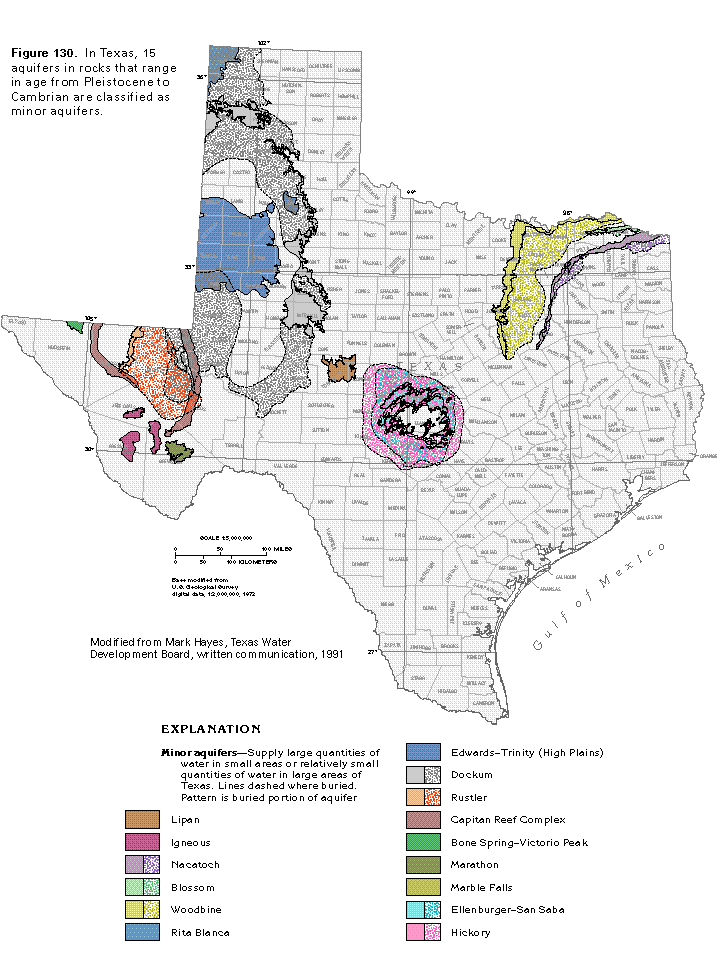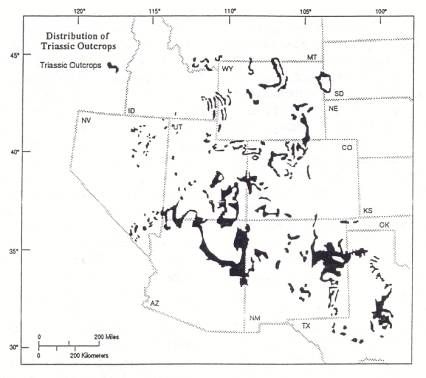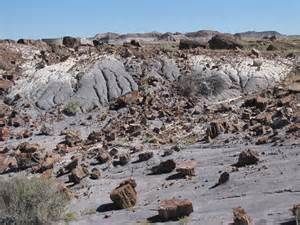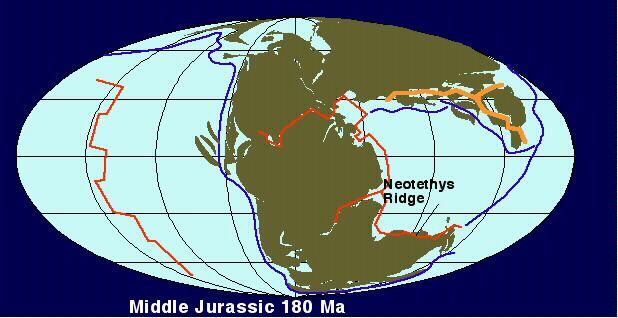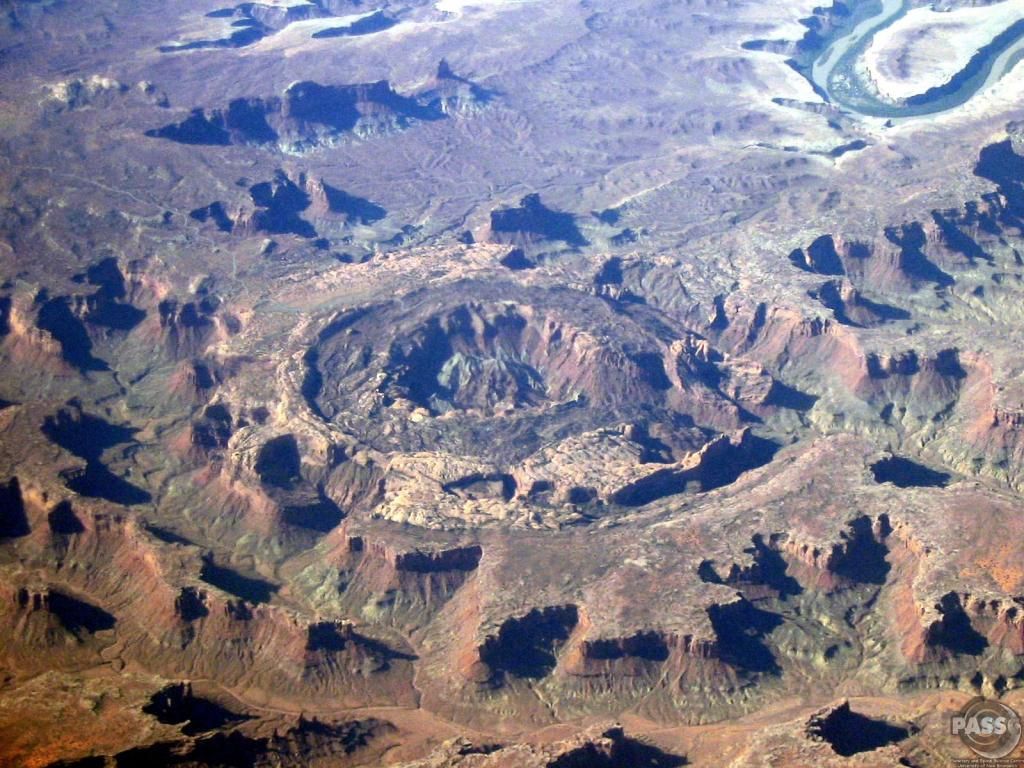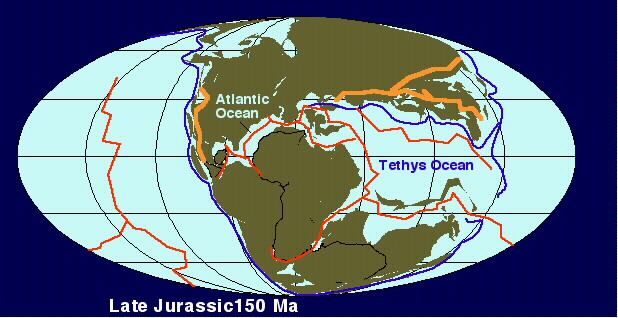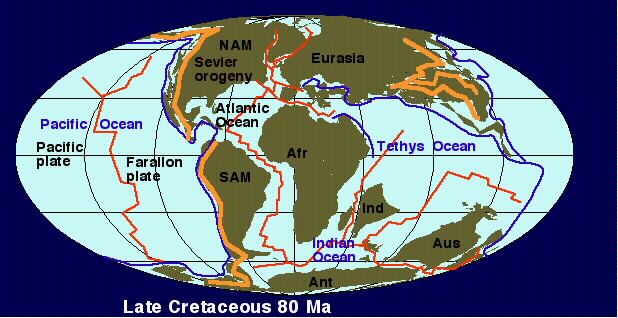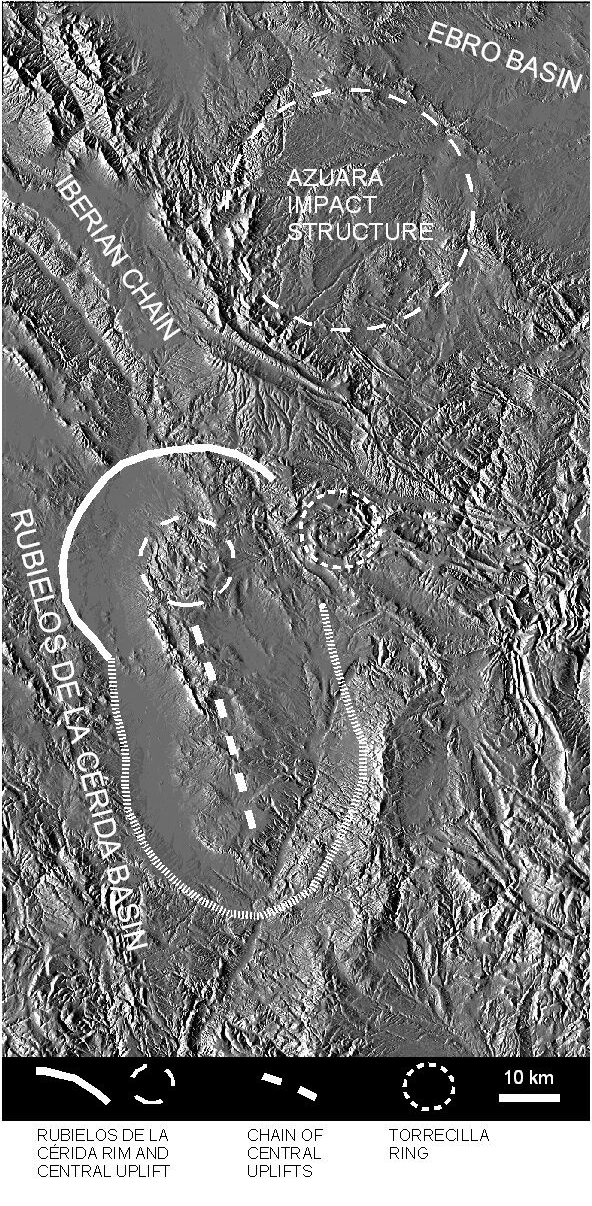Post by 1dave on Nov 30, 2014 13:56:51 GMT -5
An extension of "Geology For Rockhounds."
When looking for fossils, knowing WHEN to look is as important as knowing Where to look.
Scientists have found around 25 layers of rocks where huge collections of fossils are found.
Geologists have divided the geology record into 12 time periods bracketed by moments of massive extinctions.
What caused these massive Die-Offs?
1. Asteroid Impacts
2. Continental Collisions - Ron Blakey!
3. Flood Volcanics
4. Ice Ages
5. Tsunamis
6. Drought
Paleozoic Era . . Period . . MYA . . Life Forms
. . . . . . . . . Cambrian 600-500 Algae and simple invertebrates, like jellyfish & worms. Arthropods, brachiopods, & trilobites.
. . . . . . . . . Ordovician 500-440 Graptolites, orthocerous, & primitive fish. The first vertebrates begin to appear.
. . . . . . . . . Silurian 440-395 The first true plants appear. Crinoids & eurypterids are abundant. The first air breathers.
. . . . . . . . . Devonian 395-360 Fish evolve into more complex animals. Sharks and amphibians multiply.
Carboniferous 360-225
. . . . . . . . . Mississippian (359.2 to 318.1 mya) Upper (328.3 to 318.1 mya) Middle (345.3 to 328.3 mya) Lower (359.2 to 345.3 mya)
. . . . . . . . . Pennsylvanian (318.1 to 299.0 mya) Upper (307.2 to 299.0 mya) Middle (311.7 to 307.2 mya) Lower (318.1 to 311.7 mya)
Animal Life on dry land. Plentiful ferns. Reptiles evolve. Spiders, cockroaches, & scorpions appear.
. . . . . . . . . Permian 280-225 Reptiles become abundant. Pine-like trees develop. Trilobites become extinct.
Mesozoic Era . . Period . . MYA . . Life Forms
. . . . . . . . . Triassic 225-190 The beginning of the dinosaurs. Plant eaters, meat eaters, flying reptiles, and crocodiles.
. . . . . . . . . Jurassic 190-136 Giant dinosaurs develop. Abundant plant life & shellfish, like ammonites, lobsters, and shrimp.
. . . . . . . . . Cretaceous 136-65 The peak of development. Downfall of the great dinosaurs, like triceratops, t-rex, & pterodactyls. Deciduous trees develop.
Cenozoic Era . . Period . . MYA . . Life Forms
. . . . . . . . . Tertiary 65-2 Mammals develop, such as camels, bears, cats, monkeys, rodents, and dogs. Grasses & fruit like today’s appear.
. . . . . . . . . Quaternary 2-Present More mammals develop, like the saber-toothed tiger and mastodon. Modern man appears.
What caused those extinctions?
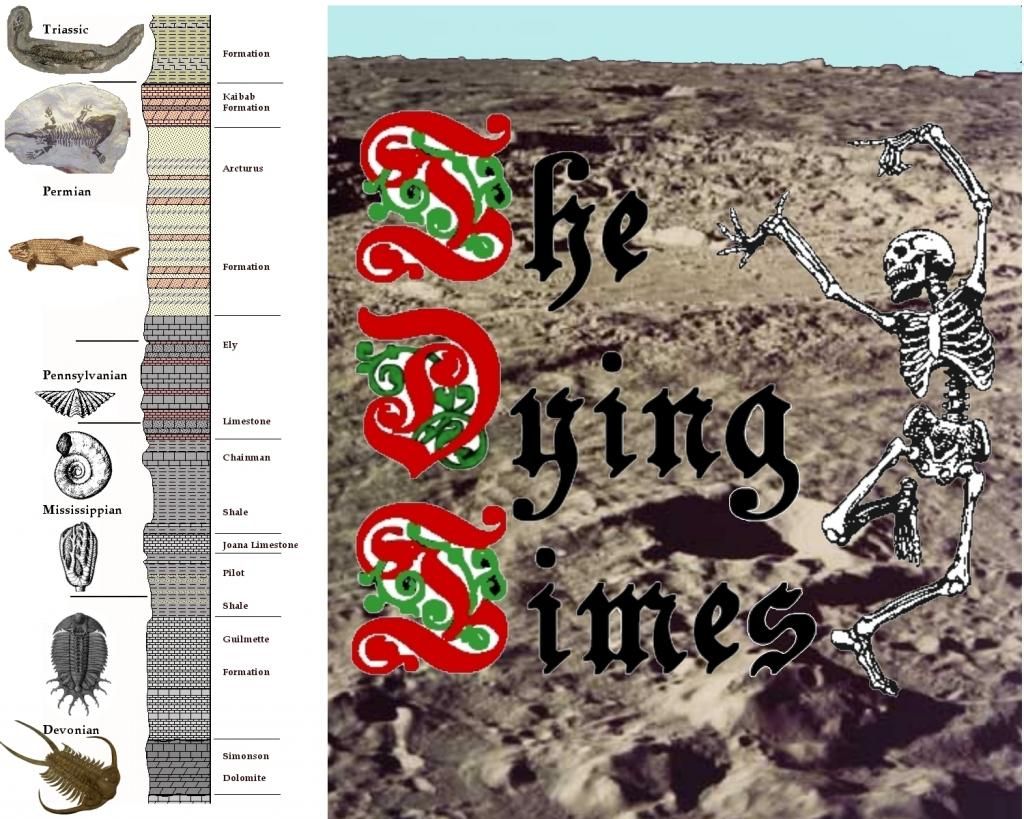
There has been a lot of speculation about a "Death Star" that kills off life every 62 (or 31) million years,
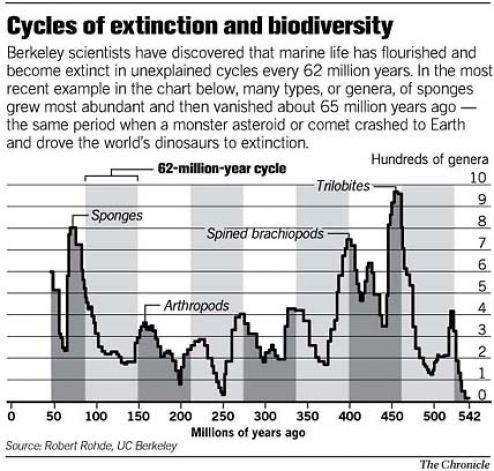
but our Cenozoic has lasted 63.2 million million years with no shattering happening when the Tertiary ended and our present Quaternary began 1.8 million years ago.
That didn't seem plausible to me, so I began my own research.
1. Scientists have concluded the universe is 13.8 Billion years old.
2. the Milky Way Galaxy is about 13.2 Billion years old. Scientists have discovered galaxies average one supernova about every hundred years, so we are surrounded by around 132 million supernova remnants.


360 degree view of the Milky Way from Earth showing "dust" in our area.
3. the Sun, solar system, and earth coalesced from that material about 4.54 Billion years ago.
Present theory is that the planets formed from dust rings around the sun.
 More probable to me is the idea that Sol, like most stars, had a partner, but it was drawn out like a string of soap bubbles by a passing massive star. Those "bubbles" became most of our planets.
More probable to me is the idea that Sol, like most stars, had a partner, but it was drawn out like a string of soap bubbles by a passing massive star. Those "bubbles" became most of our planets.

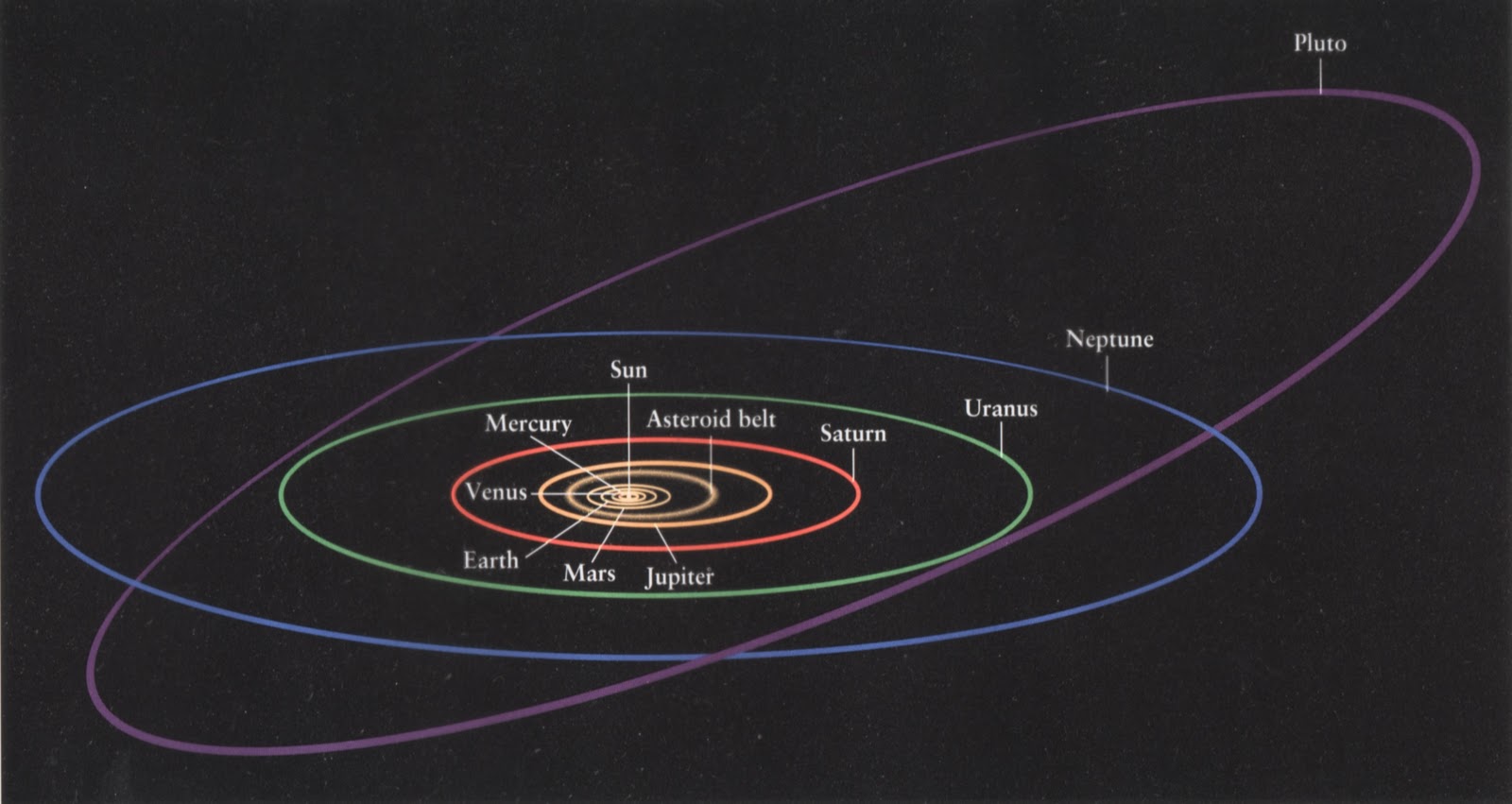
Pluto and many planetary moons obviously came from somewhere else.

Is each arm the remnant of a captured galaxy?
We return to our birthplace every 226 million years (one Galactic Year), but supernova material travels out at 1/10th the speed of light, so every ten years it has scattered one light year further from it's original center. You can't step in the same river twice.
Each full trip allows the material to expand its radius by (226m/10 =) 22 million light years, but all is still part of the Milky Way dust and larger particles we travel through.
Divide 4.54 Billion by 226 Million years per trip = about 20 full trips we have made around the galaxy so far.
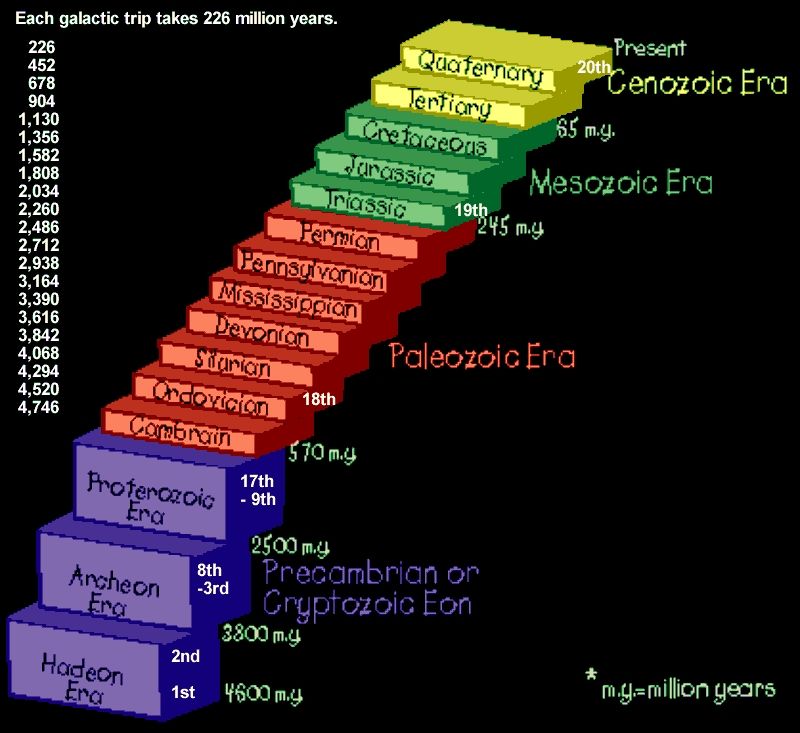
Supernovae nebulae clutter Sun and Earth’s 226 million year path around the Milky Way galaxy, like flack shot at WWII aircraft.
The elements (oxygen, silicon, silver, gold, uranium)in the “flack” depends on the mass of the star before it exploded.
An excellent presentation on supernovas is at:
abyss.uoregon.edu/~js/ast122/lectures/lec18.html
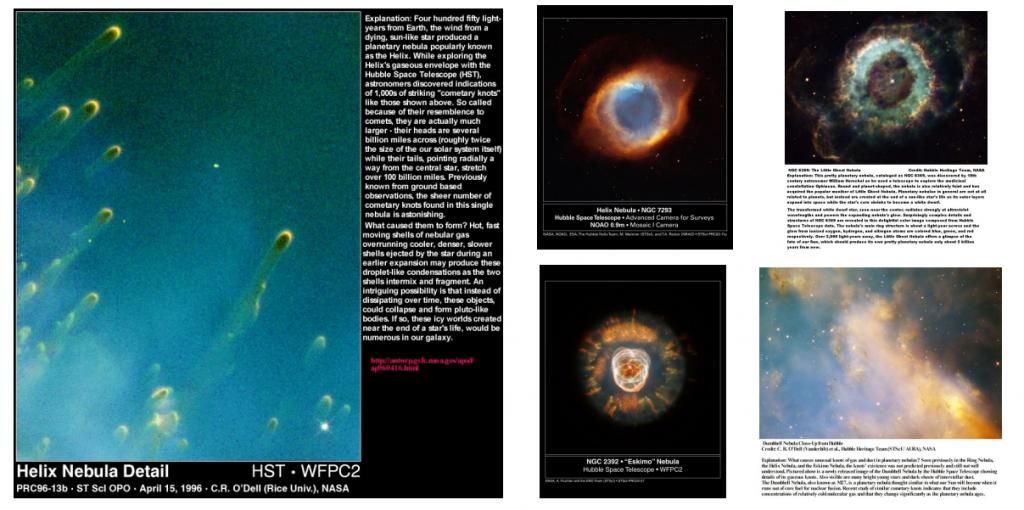
Heavy elements in massive supernovas often have enough mass to draw huge spherical clouds of material to them. Known as "cometary Knots", each of those shown in the Helix Nebula are about twice the diameter of our entire solar system, but contain about the mass of Pluto.
Sorry, I don't believe in the Oort Cloud Myth. Supernovas are where our comets and most asteroids come from.
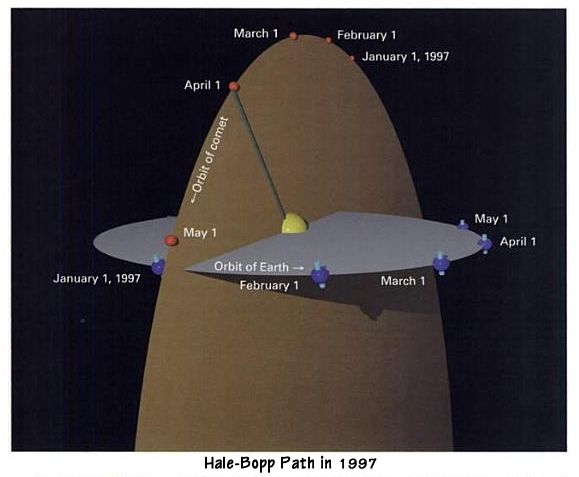
Remember the 39 members of the Heaven's Gate cult (of course California) who tried to "hitch a ride on the space ship" following the comet? The last week of March 1997.

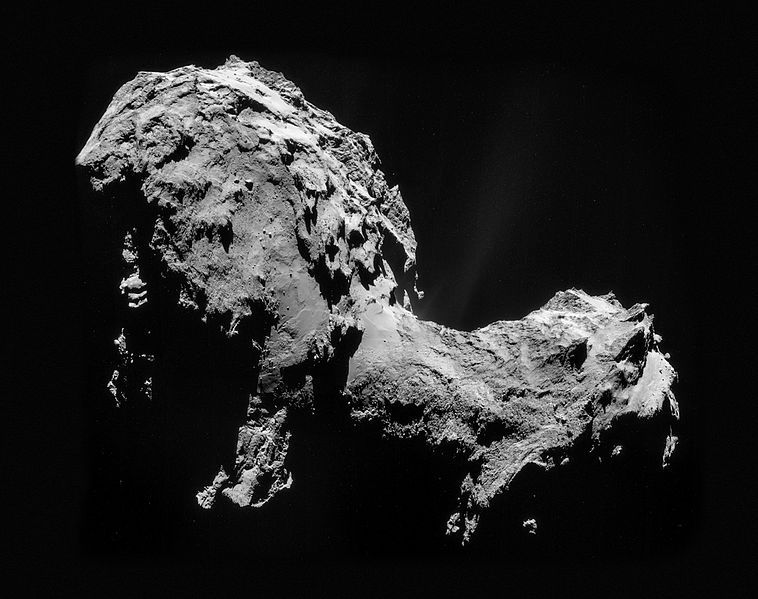
Comet 67p

Miranda, a moon of Uranus, could be the mashed together end results from a cometary knot. Joined together pieces, like scoops of ice cream, from long deep space trips with little outside influence for millions of years are evident in many comets and asteroids.
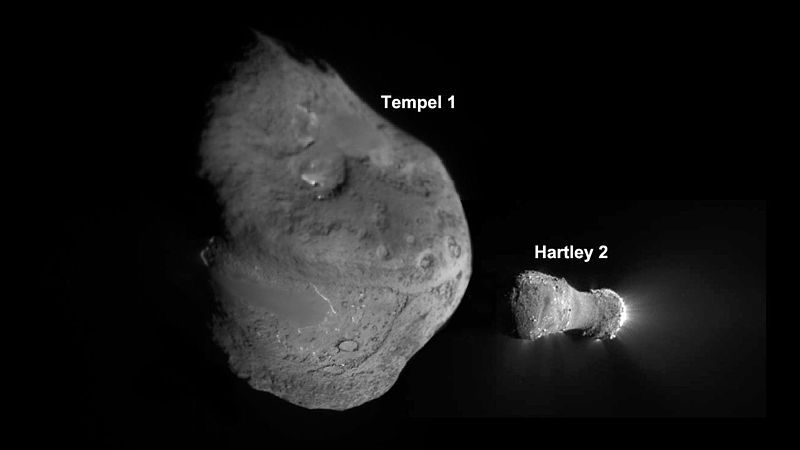
Comets Tempel1 and hartley2
Some scientists think there may be more solitary planets hurtling though interstellar space than there are stars.
Earth is continually receiving deposits from space.
Scientists speak of three kinds of meteorites. Stones, stony irons, and irons.
Reality is they consist of nearly every mineral and element combination you can imagine.
One source of “new” material is the Leonid meteors from comet Tempel-Tuttle. They represent the fastest known shower meteors, barreling in at 72 km/sec (259,200 kmph). They are well known for their bright magnitudes, and their ability to produce extremely long duration trains, some lasting up to several minutes. On the other end of the meteorite spectrum, the Giacobinids, which last produced a brief outburst in 1998, has extremely slow meteors at less than 11 km/sec.
An annual Leonid shower may deposit 12 or 13 tons of particles across our entire planet.
Measurements available from satellite penetration data (no possibility of earthly contamination) give the value from all extraterrestrial dust of about 18,000 to 25,000 tons per year. These measurements agree with levels of meteoritic dust levels trapped in sediments on Earth. (That is, they are verified by an independent cross-check.)
That might not seem like much on such a huge planet, but accumulating yearly over 4.54 billion years, it is significant!
Geology Layers.
1. Precambrian time covers the vast bulk -80%- of the Earth's history, starting with the planet's creation about 4.5 billion years ago and ending with the emergence of complex, multi-celled life-forms almost four billion years later, and includes 17 trips through the supernova flack of the galaxy shooting arcade.
2. Paleozoic time covers the next 322 million years.
3. Mesozoic time covers the next 183 million years
4. Cenozoic time covers the past 65 million years and brings us to the present.
It has been proposed that the Precambrian should be divided into eons and eras that reflect stages of planetary evolution, rather than the current scheme based upon numerical ages. Such a system could rely on events in the stratigraphic record and be demarcated by GSSPs.
The Precambrian could be divided into five "natural" eons, characterized as follows.
1.1. Accretion and differentiation: 4.55 - 4.51: of planetary formation until giant Moon-forming impact event.
Must have been heavy in iron, nickle, potassium, other heavy and radioactive elements.
1.2. Hadean: 4.51 - 4.0: dominated by heavy bombardment, (possibly including a Cool Early Earth period) to the end of the Late Heavy Bombardment period.
The oldest known rocks on Earth are the faux amphibolite volcanic deposits of the Nuvvuagittuq greenstone belt in Quebec, Canada; they are estimated to be 4.28 billion years old.
Mineral deposits associated with Precambrian rocks have yielded most of the world's gold and nickel in addition to large quantities of copper, silver, radium, and uranium.
1.3. Archean -4000-3800 Ma: a period defined by the first crustal formations (the Isua greenstone belt) until the deposition of banded iron formations due to increasing atmospheric oxygen content.) early Precambrian rocks are generally granite, schist, or gneiss. The most notable formations are the Keewatin and Coutchiching of Minnesota and the adjoining part of Canada; the Grenville of Ontario, which, however, may be late Precambrian; and the widely distributed Laurentian. The Keewatin series of rocks is composed chiefly of metamorphosed lava, with some sediments; the Coutchiching series is chiefly of sedimentary gneisses and schists. The Grenville limestone, marble, gneiss, and quartzite are predominantly metamorphosed sediments;
1.4. Transition 3800-2300 Ma : a period of continued iron banded formation until the first continental red beds.
1.5. Proterozoic 2300-570Ma: a period of modern plate tectonics until the first animals.
***************************************************************************************
Modern acolytes attempt to reconstruct the ancient records of an erratic doom clock, continually rearranging cemeteries and tombstones on time graphs trying to reconstruct how we got here, wherever here is.
There were a lot of bad days at Black Rock!
Not all events have been found, nor are all dates (Ma = Millions of years ago) accurate.
With the loss of 3/4ths of the earth's surface, and the continents constantly erasing the ocean floor records, we will probably never know more than a quarter of our impact history. Impact locations are given as - 13 Km S 16° 44', E 126° 5' - so you can copy those coordinates and paste them into Google Earth's "Fly me to:" and go to * Spider Western Australia 13 Km S 16° 44', E 126° 5' Be sure to look at this one!
So far, we think we know:
When Item (* = Impact, ~ = Flood Basalt, ^ = Major Volcanic Eruption)
4,600 Ma Our Solar System started
4,540 Ma Earth was Formed in Fire and has been around for 3/10 of all time. Imagine that!
Imagine that!
Then the most common of all geologic events, Impacts, began.
We haven’t begun to find all of them.
4,527 Ma * the Moon was separated from the Earth by a major impact.
 Were we hit by Mercury? We know it hit something big and lost it’s outer shell.
Were we hit by Mercury? We know it hit something big and lost it’s outer shell.
Two points about that collision:
1. For a long time after the collision bits and pieces were falling back on both bodies.
2. Earth's new satellite was much closer than it is now and its tidal pull made huge tidal waves and distorted surface rocks more than it continues to do at the present.
3,000 Ma * Stillwater Crater Complex USA - 300km in Diameter, oldest known surviving crater. Rich in Platinum!
300km in Diameter, oldest known surviving crater. Rich in Platinum!
They are still arguing over this one!
2,650 Ma * Yarrabubba Western Australia, Australia 30-70 km 27̊10'S, 118̊50'E
The Proterozoic Eon began 2.5 billion years ago and lasted until the first “Great Dying” 542 million years ago.
2,400 – 2,100 Ma Huronian Ice Age. Check out names like Siderian and Rhyacian Era, Paleoproterozoic, Neoproterozoic. Born in fire, and already we have Snowball Earth!

Average global temperatures during much of the Neoproterozoic Era (1 billion to 542 million years ago) were 2-3 degrees cooler (around 12 ̊C = 54 ̊F) than today’s average global temperatures (around 14 ̊C = 57 ̊F). The continents were around the south pole. That and Low Temperatures during the Neoproterozoic delivered a series of worldwide glaciations known as the Cryogenian or Sturtian (748 to 713 million years ago - lasted for 35 Million years!), Marinoan (650 to 600 million years ago - 50 Million years!), and Gaskiers (595 to 565 million years ago - another 30 million years!)
And the impacts continued!
When Item (* = Impact, ~ = Flood Basalt, ^ = Major Volcanic Eruption)
2,400 Ma * Suavjärvi Russia 16 km N 63° 7', E 33° 23'
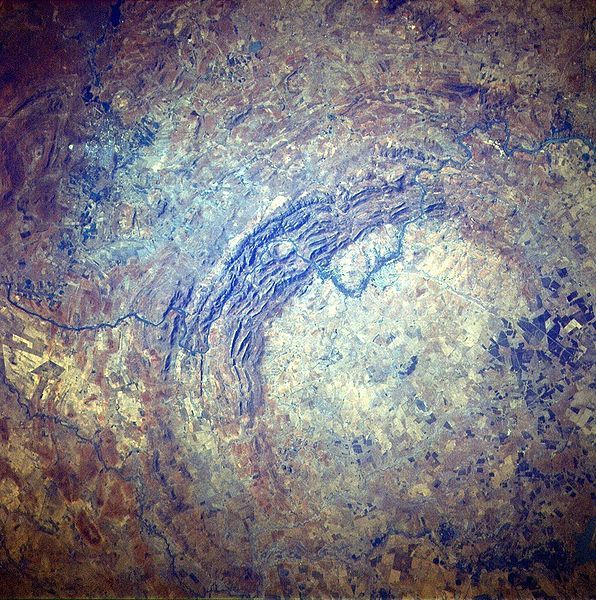
2,023 Ma * Vredefort Crater - South Africa 300 km (Size depends on which rings they include) S 27° 0', E 27° 30' Rich in Gold!
300 km (Size depends on which rings they include) S 27° 0', E 27° 30' Rich in Gold!
1,850 Ma * Sudbury Crater - Ontario, Canada 250km. N 46° 36', W 81° 11' Rich in Nickle!
250km. N 46° 36', W 81° 11' Rich in Nickle!
Compare them to the * Chelyabinsk meteorite that recently (February 15, 2013) injured over a thousand people and punched a 20 yard wide hole in a Russian lake.
 300 km. Try to Imagine that! 186.3 miles in diameter. That is HUGE, covering over 27,246 Square miles . That is larger than the entire state of West Virginia!
300 km. Try to Imagine that! 186.3 miles in diameter. That is HUGE, covering over 27,246 Square miles . That is larger than the entire state of West Virginia!
And it was only one among many. What did those early huge impacts do to move our continental plates around?
Imagine a piston that large pressing at 72 km/sec on the liquid core of the earth!
Liquids do not compress. That energy would be instantly pressed against the entire crust of the earth. Every weak point would fail, and the surface would be flooded with wave after wave of basalt.
1,800 Ma * Paasselkä Finland 10 Km N 62° 2', E 29° 5'
1,700 - 2,100 Ma * Dhala India 11 km N 25°17' 59.7", E 78°8' 3.1"
1,630? Ma * Shoemaker Western Australia, Australia 30 km 25̊52'S 120̊53'E
1,402 Ma * Matt Wilson Northern Territory 7.5 km S 15° 30', E 131° 11'
1,400-1,500 Ma * Keurusselkä, Western Finland, Finland 10-30 km 62̊8'N 24̊36'E
1,400 Ma * Goyder Northern Territory 3 km S 13° 28', E 135° 2'
1,270 Ma ~ The Coppermine River Group (Canada) part of the larger Mackenzie Large Igneous Province (One of the known flood volcano events during the Mesoproterozoic)
Coppermine River Group From Wikipedia, the free encyclopedia
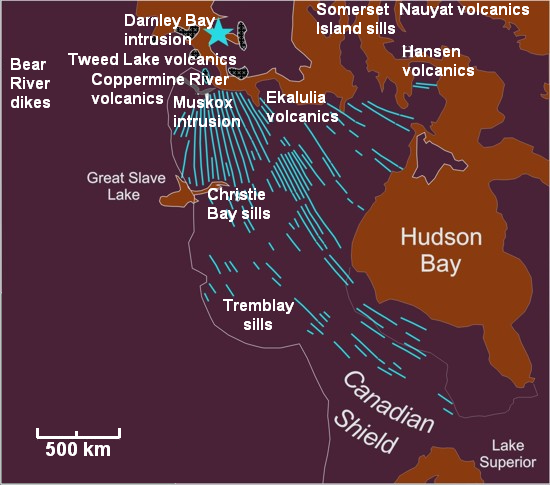
Mackenzie_Large_Igneous_Province.png
Map of the Mackenzie Large Igneous Province and its sub-features. The Coppermine River Group are shown as "Coppermine River volcanics".
The Coppermine River Group is a sequence of Mesoproterozoic continental flood basalts forming part of the Mackenzie Large Igneous Province in the Northwest Territories and Nunavut, Canada. It is among the largest flood basalt province on Earth, covering the area with a volume of approximately 650,000 km3 (155,943 cu mi).
Eruptive history
The Coppermine River Group was formed when vast volumes of basaltic lava paved over a large area of the northwestern Canadian Shield about 1,267 million years ago. These basalts form flood basalts that reach thicknesses ranging from 2,000 m (6,562 ft) to 3,500 m (11,483 ft) and consists of about 150 lava flows, each about 10-25 m thick. Except for the lowermost flows, which contain evidence of interaction with water, the entire sequence was erupted subaerially. Eruption of plateau lavas near the Coppermine River, built an extensive volcanic plateau about 1,200 million years ago with an area of about 170,000 km2 (65,637 sq mi) representing a volume of lavas of at least 500,000 km3 (119,956 cu mi). These flood basalts have been interpreted as contemporaneous with the giant Mackenzie dike swarm and with the Muskox intrusion
1,200 Ma * Santa Fe New Mexico , U.S.A. 6-13 km N 35° 45', W 105° 56'
1,180 Ma * Duluth Crater USA - 200km
Earth experienced a period of continental joining of all the major landmasses into the huge super continent of Rodinia just prior to the beginning of the Neoproterozoic.
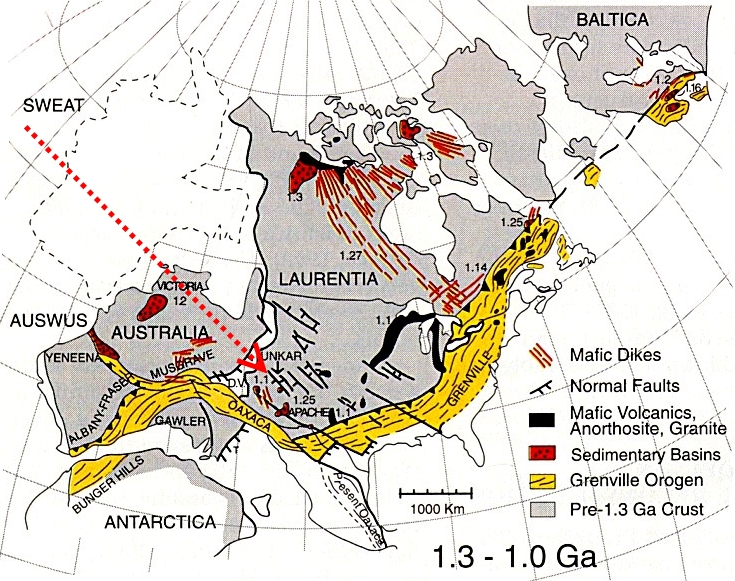
1,000 Ma * 3 Craters Finland series -3km, 4km, 9km
Rodinia was fully assembled by one billion years ago and rivaled the future Pangea in size.
Before the beginning of the Cambrian, Rodinia split in half, resulting in the creation of the Pacific Ocean west of what would become North America.
The tectonic events involved in the breakup of Rodinia and melting of the Varanger glaciers changed the ocean basins and flooded portions of many continents.
800 – 635 Ma Cryogenian (or Sturtian-Varangian) Ice Age Cryogenian Neoproterozoic Era
The second ice age, and possibly most severe, is estimated to have occurred from 850 to 635 Ma in the late Proterozoic Age and it has been suggested that it produced a second "Snowball Earth" in which the earth iced over completely.
700 Ma * Jänisjärvi Russia 14 km N 61° 58', E 30° 55'
700 - 580 Ma The Mozambique ocean began closing between Madagascar-India and the Congo-Tanzania cratons. Closure was between 600 and 500 million years ago, initiating the Pan-African orogeny, a series of major Neoproterozoic mountain building events as continental plates came together along the Mozambique Belt. It extended from east Antarctica through East Africa up to the Arabian-Nubian Shield and formed the supercontinents Gondwana and Pannotia. Angular unconformities and an intercontinental volcanic chain of andesite and rhyolite lavas dated to the Ediacaran period give ample evidence of the compression event.
A major volcanic episode recorded the Neoproterozoic-Cambrian transition in the Moroccan Anti-Atlas where the Boho Jbel and several other volcanic cones are still preserved in the El Graara massif with volcanic flows dated as Early Cambrian (U/Pb date of 534.10Ma). In the southern Moroccan Atlas, abundant volcanic and sedimentary formations, dated from the Ediacaran to Cambrian time, were set at the northwestern Paleo-Gondwanan margin, after the main Pan-African orogenic event.
646 Ma * Strangways Northern Territory, Australia 25 km 15̊12'S 133̊35'E
600-1660 Ma * Amelia Creek, Northern Territory, Australia 20 km 20̊55'S 134̊50'E
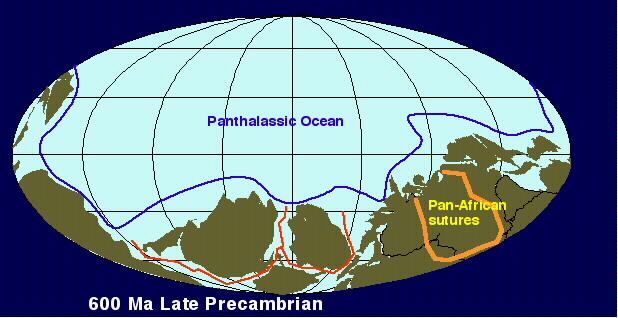
635-542 Ma The Ediacaran Period is the time from the end of global Marinoan glaciation to the first appearance worldwide of trace fossils (Treptichnus pedum). During the Ediacaran period two main groups of organisms are found in the fossil record: the "Ediacara biota" of soft-bodied organisms preserved by microbial mats, and carbonate skeletons of Cloudina and Namacalathus.
It’s beginning is defined by a chemically distinctive carbonate layer that is referred to as a "cap carbonate", because it caps glacial deposits indicating a sudden climatic change at the end of the Marinoan ice age.
:?: Why did the world warm up?
600 Ma * Saarijärvi Finland 1.5 km N 65° 17', E 28° 23'
600 Ma * Beaverhead Idaho and Montana, United States 60 km 44̊15'N 114̊0'W
600 Ma * Söderfjärden Finland 6.6 km N 63° 2', E 21° 35'
580 Ma * Acraman South Australia, Australia 85-90 km 32̊1'S 135̊27'E
573 Ma * Luizi Democratic Republic of Congo 17 km S 10° 10', E 28° 00'
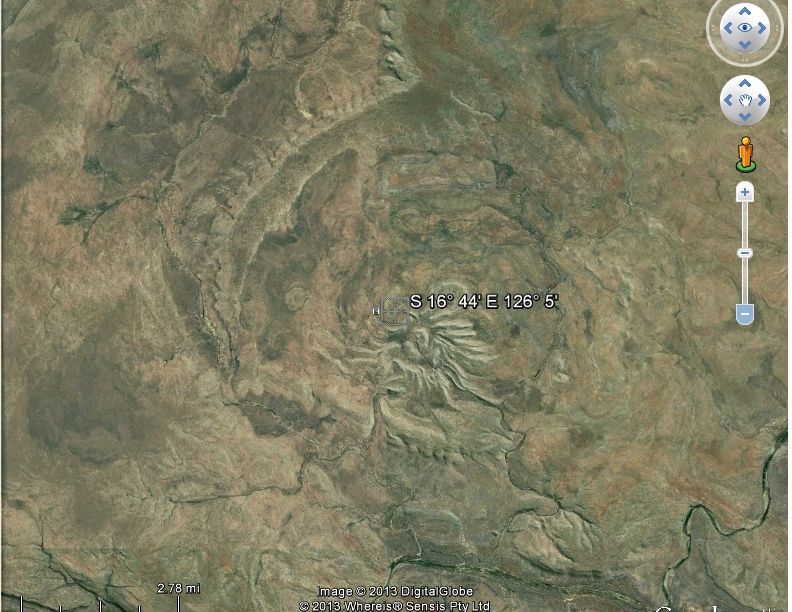
570 Ma * Spider Western Australia 13 Km S 16° 44', E 126° 5'
560 Ma * Sääksjärvi Finland 6 km N 61° 24', E 22° 24'
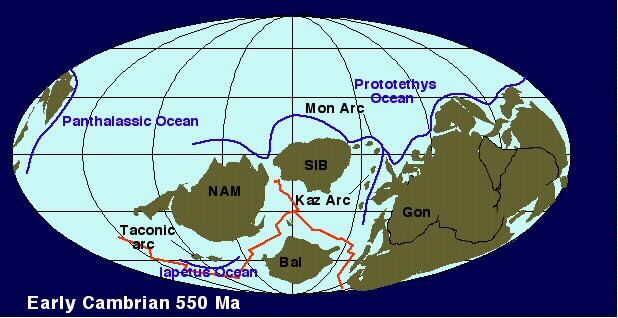
550 Ma * Kelly West Northern Territory 10 km S 19° 56', E 133° 57'
550 Ma * Holleford Ontario, Canada 2.35 km N 44° 28', W 76° 38'
545 Ma * Foelsche Northern Territory 6 km S 16° 40', E 136° 47'
Where early proterozoic rocks are found in Utah they have been under great pressure and changed to schist and GNEISS, pronounced "nice".
542 Ma scarce life forms
When looking for fossils, knowing WHEN to look is as important as knowing Where to look.
en.wikipedia.org/wiki/Evolutionary_history_of_life
Earth formed about 4.5 Ga (billion years) ago and there is evidence that life appeared within 0.5 billion years.[1]
Earth formed about 4.5 Ga (billion years) ago and there is evidence that life appeared within 0.5 billion years.[1]
Scientists have found around 25 layers of rocks where huge collections of fossils are found.
Geologists have divided the geology record into 12 time periods bracketed by moments of massive extinctions.
What caused these massive Die-Offs?
1. Asteroid Impacts
2. Continental Collisions - Ron Blakey!
3. Flood Volcanics
4. Ice Ages
5. Tsunamis
6. Drought
Click on an ORANGE time period to go directly to it.
Development of Life During The Geologic Eras
Paleozoic Era . . Period . . MYA . . Life Forms
. . . . . . . . . Cambrian 600-500 Algae and simple invertebrates, like jellyfish & worms. Arthropods, brachiopods, & trilobites.
. . . . . . . . . Ordovician 500-440 Graptolites, orthocerous, & primitive fish. The first vertebrates begin to appear.
. . . . . . . . . Silurian 440-395 The first true plants appear. Crinoids & eurypterids are abundant. The first air breathers.
. . . . . . . . . Devonian 395-360 Fish evolve into more complex animals. Sharks and amphibians multiply.
Carboniferous 360-225
. . . . . . . . . Mississippian (359.2 to 318.1 mya) Upper (328.3 to 318.1 mya) Middle (345.3 to 328.3 mya) Lower (359.2 to 345.3 mya)
. . . . . . . . . Pennsylvanian (318.1 to 299.0 mya) Upper (307.2 to 299.0 mya) Middle (311.7 to 307.2 mya) Lower (318.1 to 311.7 mya)
Animal Life on dry land. Plentiful ferns. Reptiles evolve. Spiders, cockroaches, & scorpions appear.
. . . . . . . . . Permian 280-225 Reptiles become abundant. Pine-like trees develop. Trilobites become extinct.
Mesozoic Era . . Period . . MYA . . Life Forms
. . . . . . . . . Triassic 225-190 The beginning of the dinosaurs. Plant eaters, meat eaters, flying reptiles, and crocodiles.
. . . . . . . . . Jurassic 190-136 Giant dinosaurs develop. Abundant plant life & shellfish, like ammonites, lobsters, and shrimp.
. . . . . . . . . Cretaceous 136-65 The peak of development. Downfall of the great dinosaurs, like triceratops, t-rex, & pterodactyls. Deciduous trees develop.
Cenozoic Era . . Period . . MYA . . Life Forms
. . . . . . . . . Tertiary 65-2 Mammals develop, such as camels, bears, cats, monkeys, rodents, and dogs. Grasses & fruit like today’s appear.
. . . . . . . . . Quaternary 2-Present More mammals develop, like the saber-toothed tiger and mastodon. Modern man appears.
What caused those extinctions?

There has been a lot of speculation about a "Death Star" that kills off life every 62 (or 31) million years,

but our Cenozoic has lasted 63.2 million million years with no shattering happening when the Tertiary ended and our present Quaternary began 1.8 million years ago.
That didn't seem plausible to me, so I began my own research.
1. Scientists have concluded the universe is 13.8 Billion years old.
I believe there was a supernova that created a Black Hole in a prior universe. We were sucked in.
That was our "big Bang" and we are in a black hole.
That was our "big Bang" and we are in a black hole.
2. the Milky Way Galaxy is about 13.2 Billion years old. Scientists have discovered galaxies average one supernova about every hundred years, so we are surrounded by around 132 million supernova remnants.


360 degree view of the Milky Way from Earth showing "dust" in our area.
3. the Sun, solar system, and earth coalesced from that material about 4.54 Billion years ago.
Present theory is that the planets formed from dust rings around the sun.
 More probable to me is the idea that Sol, like most stars, had a partner, but it was drawn out like a string of soap bubbles by a passing massive star. Those "bubbles" became most of our planets.
More probable to me is the idea that Sol, like most stars, had a partner, but it was drawn out like a string of soap bubbles by a passing massive star. Those "bubbles" became most of our planets.Fluids, by virtue of their surface tensions, tend to minimize their surface area. They become spheres.
When stretched, they develop waists every where they become longer than 3.13 to 3.18 times their diameters, then those waists snap into a series of smaller spheres with the same volume but less surface area. This is known as the Plateau–Rayleigh instability.
When stretched, they develop waists every where they become longer than 3.13 to 3.18 times their diameters, then those waists snap into a series of smaller spheres with the same volume but less surface area. This is known as the Plateau–Rayleigh instability.


Pluto and many planetary moons obviously came from somewhere else.

Is each arm the remnant of a captured galaxy?
We return to our birthplace every 226 million years (one Galactic Year), but supernova material travels out at 1/10th the speed of light, so every ten years it has scattered one light year further from it's original center. You can't step in the same river twice.
Each full trip allows the material to expand its radius by (226m/10 =) 22 million light years, but all is still part of the Milky Way dust and larger particles we travel through.
Divide 4.54 Billion by 226 Million years per trip = about 20 full trips we have made around the galaxy so far.

Supernovae nebulae clutter Sun and Earth’s 226 million year path around the Milky Way galaxy, like flack shot at WWII aircraft.
The elements (oxygen, silicon, silver, gold, uranium)in the “flack” depends on the mass of the star before it exploded.
An excellent presentation on supernovas is at:
abyss.uoregon.edu/~js/ast122/lectures/lec18.html

Heavy elements in massive supernovas often have enough mass to draw huge spherical clouds of material to them. Known as "cometary Knots", each of those shown in the Helix Nebula are about twice the diameter of our entire solar system, but contain about the mass of Pluto.
Over time the particles inside cometary knots collect on "seeds" like hail stones forming in a thunder cloud, getting ever larger, like huge scoops of ice cream sticking together.
Sorry, I don't believe in the Oort Cloud Myth. Supernovas are where our comets and most asteroids come from.

Remember the 39 members of the Heaven's Gate cult (of course California) who tried to "hitch a ride on the space ship" following the comet? The last week of March 1997.


Comet 67p

Miranda, a moon of Uranus, could be the mashed together end results from a cometary knot. Joined together pieces, like scoops of ice cream, from long deep space trips with little outside influence for millions of years are evident in many comets and asteroids.

Comets Tempel1 and hartley2
Some scientists think there may be more solitary planets hurtling though interstellar space than there are stars.
Earth is continually receiving deposits from space.
Scientists speak of three kinds of meteorites. Stones, stony irons, and irons.
Reality is they consist of nearly every mineral and element combination you can imagine.
One source of “new” material is the Leonid meteors from comet Tempel-Tuttle. They represent the fastest known shower meteors, barreling in at 72 km/sec (259,200 kmph). They are well known for their bright magnitudes, and their ability to produce extremely long duration trains, some lasting up to several minutes. On the other end of the meteorite spectrum, the Giacobinids, which last produced a brief outburst in 1998, has extremely slow meteors at less than 11 km/sec.
An annual Leonid shower may deposit 12 or 13 tons of particles across our entire planet.
Measurements available from satellite penetration data (no possibility of earthly contamination) give the value from all extraterrestrial dust of about 18,000 to 25,000 tons per year. These measurements agree with levels of meteoritic dust levels trapped in sediments on Earth. (That is, they are verified by an independent cross-check.)
That might not seem like much on such a huge planet, but accumulating yearly over 4.54 billion years, it is significant!
Geology Layers.
1. Precambrian time covers the vast bulk -80%- of the Earth's history, starting with the planet's creation about 4.5 billion years ago and ending with the emergence of complex, multi-celled life-forms almost four billion years later, and includes 17 trips through the supernova flack of the galaxy shooting arcade.
2. Paleozoic time covers the next 322 million years.
3. Mesozoic time covers the next 183 million years
4. Cenozoic time covers the past 65 million years and brings us to the present.
It has been proposed that the Precambrian should be divided into eons and eras that reflect stages of planetary evolution, rather than the current scheme based upon numerical ages. Such a system could rely on events in the stratigraphic record and be demarcated by GSSPs.
A Global Boundary Stratotype Section and Point, abbreviated GSSP, is an internationally agreed upon reference point on a stratigraphic section which defines the lower boundary of a stage on the geologic time scale.
The Precambrian could be divided into five "natural" eons, characterized as follows.
1.1. Accretion and differentiation: 4.55 - 4.51: of planetary formation until giant Moon-forming impact event.
Must have been heavy in iron, nickle, potassium, other heavy and radioactive elements.
1.2. Hadean: 4.51 - 4.0: dominated by heavy bombardment, (possibly including a Cool Early Earth period) to the end of the Late Heavy Bombardment period.
The oldest known rocks on Earth are the faux amphibolite volcanic deposits of the Nuvvuagittuq greenstone belt in Quebec, Canada; they are estimated to be 4.28 billion years old.
Mineral deposits associated with Precambrian rocks have yielded most of the world's gold and nickel in addition to large quantities of copper, silver, radium, and uranium.
1.3. Archean -4000-3800 Ma: a period defined by the first crustal formations (the Isua greenstone belt) until the deposition of banded iron formations due to increasing atmospheric oxygen content.) early Precambrian rocks are generally granite, schist, or gneiss. The most notable formations are the Keewatin and Coutchiching of Minnesota and the adjoining part of Canada; the Grenville of Ontario, which, however, may be late Precambrian; and the widely distributed Laurentian. The Keewatin series of rocks is composed chiefly of metamorphosed lava, with some sediments; the Coutchiching series is chiefly of sedimentary gneisses and schists. The Grenville limestone, marble, gneiss, and quartzite are predominantly metamorphosed sediments;
1.4. Transition 3800-2300 Ma : a period of continued iron banded formation until the first continental red beds.
1.5. Proterozoic 2300-570Ma: a period of modern plate tectonics until the first animals.
***************************************************************************************
Early Earth reconstruction Images are from jan.ucc.nau.edu/~rcb7/1storder.html by Dr. Ron Blakely, Professor of Geology at Northern Arizona University.
Modern acolytes attempt to reconstruct the ancient records of an erratic doom clock, continually rearranging cemeteries and tombstones on time graphs trying to reconstruct how we got here, wherever here is.
There were a lot of bad days at Black Rock!
Not all events have been found, nor are all dates (Ma = Millions of years ago) accurate.
With the loss of 3/4ths of the earth's surface, and the continents constantly erasing the ocean floor records, we will probably never know more than a quarter of our impact history. Impact locations are given as - 13 Km S 16° 44', E 126° 5' - so you can copy those coordinates and paste them into Google Earth's "Fly me to:" and go to * Spider Western Australia 13 Km S 16° 44', E 126° 5' Be sure to look at this one!
So far, we think we know:
When Item (* = Impact, ~ = Flood Basalt, ^ = Major Volcanic Eruption)
4,600 Ma Our Solar System started
4,540 Ma Earth was Formed in Fire and has been around for 3/10 of all time.
 Imagine that!
Imagine that!Then the most common of all geologic events, Impacts, began.
We haven’t begun to find all of them.
4,527 Ma * the Moon was separated from the Earth by a major impact.
 Were we hit by Mercury? We know it hit something big and lost it’s outer shell.
Were we hit by Mercury? We know it hit something big and lost it’s outer shell.Two points about that collision:
1. For a long time after the collision bits and pieces were falling back on both bodies.
2. Earth's new satellite was much closer than it is now and its tidal pull made huge tidal waves and distorted surface rocks more than it continues to do at the present.
3,000 Ma * Stillwater Crater Complex USA -
 300km in Diameter, oldest known surviving crater. Rich in Platinum!
300km in Diameter, oldest known surviving crater. Rich in Platinum!They are still arguing over this one!
2,650 Ma * Yarrabubba Western Australia, Australia 30-70 km 27̊10'S, 118̊50'E
The Proterozoic Eon began 2.5 billion years ago and lasted until the first “Great Dying” 542 million years ago.
2,400 – 2,100 Ma Huronian Ice Age. Check out names like Siderian and Rhyacian Era, Paleoproterozoic, Neoproterozoic. Born in fire, and already we have Snowball Earth!

Average global temperatures during much of the Neoproterozoic Era (1 billion to 542 million years ago) were 2-3 degrees cooler (around 12 ̊C = 54 ̊F) than today’s average global temperatures (around 14 ̊C = 57 ̊F). The continents were around the south pole. That and Low Temperatures during the Neoproterozoic delivered a series of worldwide glaciations known as the Cryogenian or Sturtian (748 to 713 million years ago - lasted for 35 Million years!), Marinoan (650 to 600 million years ago - 50 Million years!), and Gaskiers (595 to 565 million years ago - another 30 million years!)
And the impacts continued!
NOTE: Earth is a "Differentiated Planet." That means it melted and ALL the heavy stuff like gold, platinum, lead, uranium, plutonium, etc. sank to the center in an "iron coffin,"and the light stuff like silica and aluminum floated to the top.
That means that all heavy stuff presently found near the surface came later!
That means that all heavy stuff presently found near the surface came later!
When Item (* = Impact, ~ = Flood Basalt, ^ = Major Volcanic Eruption)
2,400 Ma * Suavjärvi Russia 16 km N 63° 7', E 33° 23'

2,023 Ma * Vredefort Crater - South Africa
 300 km (Size depends on which rings they include) S 27° 0', E 27° 30' Rich in Gold!
300 km (Size depends on which rings they include) S 27° 0', E 27° 30' Rich in Gold!1,850 Ma * Sudbury Crater - Ontario, Canada
 250km. N 46° 36', W 81° 11' Rich in Nickle!
250km. N 46° 36', W 81° 11' Rich in Nickle!Compare them to the * Chelyabinsk meteorite that recently (February 15, 2013) injured over a thousand people and punched a 20 yard wide hole in a Russian lake.
 300 km. Try to Imagine that! 186.3 miles in diameter. That is HUGE, covering over 27,246 Square miles . That is larger than the entire state of West Virginia!
300 km. Try to Imagine that! 186.3 miles in diameter. That is HUGE, covering over 27,246 Square miles . That is larger than the entire state of West Virginia!And it was only one among many. What did those early huge impacts do to move our continental plates around?
Imagine a piston that large pressing at 72 km/sec on the liquid core of the earth!
Liquids do not compress. That energy would be instantly pressed against the entire crust of the earth. Every weak point would fail, and the surface would be flooded with wave after wave of basalt.
1,800 Ma * Paasselkä Finland 10 Km N 62° 2', E 29° 5'
1,700 - 2,100 Ma * Dhala India 11 km N 25°17' 59.7", E 78°8' 3.1"
1,630? Ma * Shoemaker Western Australia, Australia 30 km 25̊52'S 120̊53'E
1,402 Ma * Matt Wilson Northern Territory 7.5 km S 15° 30', E 131° 11'
1,400-1,500 Ma * Keurusselkä, Western Finland, Finland 10-30 km 62̊8'N 24̊36'E
1,400 Ma * Goyder Northern Territory 3 km S 13° 28', E 135° 2'
1,270 Ma ~ The Coppermine River Group (Canada) part of the larger Mackenzie Large Igneous Province (One of the known flood volcano events during the Mesoproterozoic)
Coppermine River Group From Wikipedia, the free encyclopedia

Mackenzie_Large_Igneous_Province.png
Map of the Mackenzie Large Igneous Province and its sub-features. The Coppermine River Group are shown as "Coppermine River volcanics".
The Coppermine River Group is a sequence of Mesoproterozoic continental flood basalts forming part of the Mackenzie Large Igneous Province in the Northwest Territories and Nunavut, Canada. It is among the largest flood basalt province on Earth, covering the area with a volume of approximately 650,000 km3 (155,943 cu mi).
Eruptive history
The Coppermine River Group was formed when vast volumes of basaltic lava paved over a large area of the northwestern Canadian Shield about 1,267 million years ago. These basalts form flood basalts that reach thicknesses ranging from 2,000 m (6,562 ft) to 3,500 m (11,483 ft) and consists of about 150 lava flows, each about 10-25 m thick. Except for the lowermost flows, which contain evidence of interaction with water, the entire sequence was erupted subaerially. Eruption of plateau lavas near the Coppermine River, built an extensive volcanic plateau about 1,200 million years ago with an area of about 170,000 km2 (65,637 sq mi) representing a volume of lavas of at least 500,000 km3 (119,956 cu mi). These flood basalts have been interpreted as contemporaneous with the giant Mackenzie dike swarm and with the Muskox intrusion
1,200 Ma * Santa Fe New Mexico , U.S.A. 6-13 km N 35° 45', W 105° 56'
1,180 Ma * Duluth Crater USA - 200km
Earth experienced a period of continental joining of all the major landmasses into the huge super continent of Rodinia just prior to the beginning of the Neoproterozoic.

1,000 Ma * 3 Craters Finland series -3km, 4km, 9km
Rodinia was fully assembled by one billion years ago and rivaled the future Pangea in size.
Before the beginning of the Cambrian, Rodinia split in half, resulting in the creation of the Pacific Ocean west of what would become North America.
The tectonic events involved in the breakup of Rodinia and melting of the Varanger glaciers changed the ocean basins and flooded portions of many continents.
800 – 635 Ma Cryogenian (or Sturtian-Varangian) Ice Age Cryogenian Neoproterozoic Era
The second ice age, and possibly most severe, is estimated to have occurred from 850 to 635 Ma in the late Proterozoic Age and it has been suggested that it produced a second "Snowball Earth" in which the earth iced over completely.
700 Ma * Jänisjärvi Russia 14 km N 61° 58', E 30° 55'
700 - 580 Ma The Mozambique ocean began closing between Madagascar-India and the Congo-Tanzania cratons. Closure was between 600 and 500 million years ago, initiating the Pan-African orogeny, a series of major Neoproterozoic mountain building events as continental plates came together along the Mozambique Belt. It extended from east Antarctica through East Africa up to the Arabian-Nubian Shield and formed the supercontinents Gondwana and Pannotia. Angular unconformities and an intercontinental volcanic chain of andesite and rhyolite lavas dated to the Ediacaran period give ample evidence of the compression event.
A major volcanic episode recorded the Neoproterozoic-Cambrian transition in the Moroccan Anti-Atlas where the Boho Jbel and several other volcanic cones are still preserved in the El Graara massif with volcanic flows dated as Early Cambrian (U/Pb date of 534.10Ma). In the southern Moroccan Atlas, abundant volcanic and sedimentary formations, dated from the Ediacaran to Cambrian time, were set at the northwestern Paleo-Gondwanan margin, after the main Pan-African orogenic event.
646 Ma * Strangways Northern Territory, Australia 25 km 15̊12'S 133̊35'E
600-1660 Ma * Amelia Creek, Northern Territory, Australia 20 km 20̊55'S 134̊50'E

635-542 Ma The Ediacaran Period is the time from the end of global Marinoan glaciation to the first appearance worldwide of trace fossils (Treptichnus pedum). During the Ediacaran period two main groups of organisms are found in the fossil record: the "Ediacara biota" of soft-bodied organisms preserved by microbial mats, and carbonate skeletons of Cloudina and Namacalathus.
It’s beginning is defined by a chemically distinctive carbonate layer that is referred to as a "cap carbonate", because it caps glacial deposits indicating a sudden climatic change at the end of the Marinoan ice age.
:?: Why did the world warm up?
600 Ma * Saarijärvi Finland 1.5 km N 65° 17', E 28° 23'
600 Ma * Beaverhead Idaho and Montana, United States 60 km 44̊15'N 114̊0'W
600 Ma * Söderfjärden Finland 6.6 km N 63° 2', E 21° 35'
580 Ma * Acraman South Australia, Australia 85-90 km 32̊1'S 135̊27'E
573 Ma * Luizi Democratic Republic of Congo 17 km S 10° 10', E 28° 00'

570 Ma * Spider Western Australia 13 Km S 16° 44', E 126° 5'
560 Ma * Sääksjärvi Finland 6 km N 61° 24', E 22° 24'

550 Ma * Kelly West Northern Territory 10 km S 19° 56', E 133° 57'
550 Ma * Holleford Ontario, Canada 2.35 km N 44° 28', W 76° 38'
545 Ma * Foelsche Northern Territory 6 km S 16° 40', E 136° 47'
Where early proterozoic rocks are found in Utah they have been under great pressure and changed to schist and GNEISS, pronounced "nice".
542 Ma scarce life forms
POST MORTEM: Evidence of a Precambrian mass extinction at the end of the Vendian-Ediacaran period includes:
The disappearance of acritarchs, ediacara biota and calcifying organisms.
Sedimentary evidence in the geological record is an increase in black shale deposition, representing global anoxia.
The time gap of several million years in the rocks before Cambrian organisms finally appear.
Evidence that Earth’s first mass extinction was caused by critters, not catastrophe
The disappearance of acritarchs, ediacara biota and calcifying organisms.
Sedimentary evidence in the geological record is an increase in black shale deposition, representing global anoxia.
The time gap of several million years in the rocks before Cambrian organisms finally appear.
Evidence that Earth’s first mass extinction was caused by critters, not catastrophe
The earliest life on Earth consisted of microbes – various types of single-celled microorganisms. They ruled the Earth for more than 3 billion years. Then some of these microorganisms discovered how to capture the energy in sunlight. The photosynthetic process that they developed had a toxic byproduct: oxygen. Oxygen was poisonous to most microbes that had evolved in an oxygen-free environment, making it the world’s first pollutant.
But for the microorganisms that developed methods for protecting themselves, oxygen served as a powerful new energy source. Among a number of other things, it gave them the added energy they needed to adopt multicellular forms. Thus, the Ediacarans arose about 600 million years ago during a warm period following a long interval of extensive glaciation.
“We don’t know very much about the Ediacarans because they did not produce shells or skeletons. As a result, almost all we know about them comes from imprints of their shapes preserved in sand or ash,” said Darroch.
portrait
Simon Darroch (Steve Green / Vanderbilt)
What scientists do know is that, in their heyday, Ediacarans spread throughout the planet. They were a largely immobile form of marine life shaped like discs and tubes, fronds and quilted mattresses. The majority were extremely passive, remaining attached in one spot for their entire lives. Many fed by absorbing chemicals from the water through their outer membranes, rather than actively gathering nutrients.
Paleontologists have coined the term “Garden of Ediacara” to convey the peace and tranquility that must have prevailed during this period. But there was a lot of churning going on beneath that apparently serene surface.
After 60 million years, evolution gave birth to another major innovation: animals. All animals share the characteristics that they can move spontaneously and independently, at least during some point in their lives, and sustain themselves by eating other organisms or what they produce. Animals burst onto the scene in a frenzy of diversification that paleontologists have labeled the Cambrian explosion, a 25-million-year period when most of the modern animal families – vertebrates, molluscs, arthropods, annelids, sponges and jellyfish – came into being.
“These new species were ‘ecological engineers’ who changed the environment in ways that made it more and more difficult for the Ediacarans to survive,” said Darroch.
But for the microorganisms that developed methods for protecting themselves, oxygen served as a powerful new energy source. Among a number of other things, it gave them the added energy they needed to adopt multicellular forms. Thus, the Ediacarans arose about 600 million years ago during a warm period following a long interval of extensive glaciation.
“We don’t know very much about the Ediacarans because they did not produce shells or skeletons. As a result, almost all we know about them comes from imprints of their shapes preserved in sand or ash,” said Darroch.
portrait
Simon Darroch (Steve Green / Vanderbilt)
What scientists do know is that, in their heyday, Ediacarans spread throughout the planet. They were a largely immobile form of marine life shaped like discs and tubes, fronds and quilted mattresses. The majority were extremely passive, remaining attached in one spot for their entire lives. Many fed by absorbing chemicals from the water through their outer membranes, rather than actively gathering nutrients.
Paleontologists have coined the term “Garden of Ediacara” to convey the peace and tranquility that must have prevailed during this period. But there was a lot of churning going on beneath that apparently serene surface.
After 60 million years, evolution gave birth to another major innovation: animals. All animals share the characteristics that they can move spontaneously and independently, at least during some point in their lives, and sustain themselves by eating other organisms or what they produce. Animals burst onto the scene in a frenzy of diversification that paleontologists have labeled the Cambrian explosion, a 25-million-year period when most of the modern animal families – vertebrates, molluscs, arthropods, annelids, sponges and jellyfish – came into being.
“These new species were ‘ecological engineers’ who changed the environment in ways that made it more and more difficult for the Ediacarans to survive,” said Darroch.

